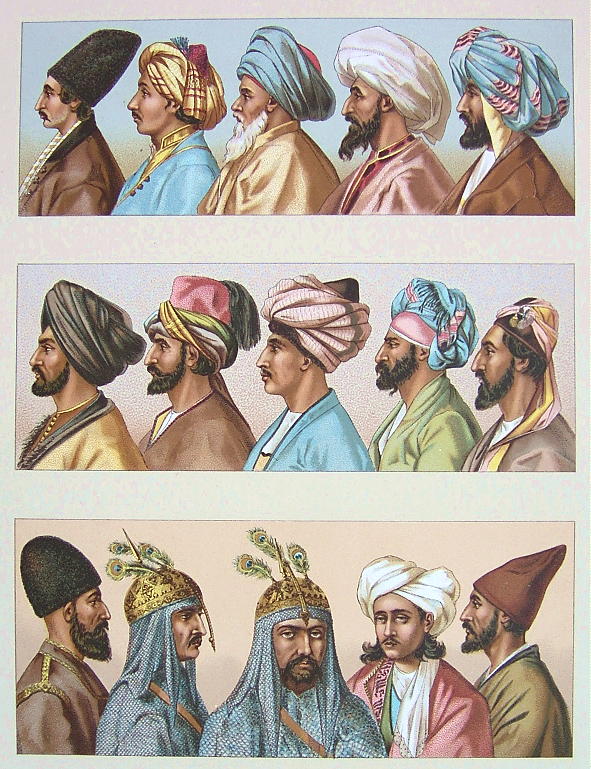

"Turbans and bonnets of the Middle East," 1888
Source: ebay, Apr. 2006
"THE PEOPLES OF THE MIDDLE EAST ARE HIGHLY SKILLED in the art of winding a turban. However, although there is a long tradition behind the method used - an Ottoman tradition in fact - the many different styles that appear in the illustrations opposite demonstrate quite clearly that there are no hard and fast rules. A turban's appearance can be changed to match a particular costume, to comply with local fashion, or, indeed, to satisfy a personal whim. A turban is generally made from a 15ft- or 16ft-long square of material. Two people are required: one holds two comers while the other takes the opposite bottom comer in one hand, so that the top comer that is left falls diagonally. Both people turn the material inside out simultaneously - as if they were wringing out wet washing. To adjust the turban on the head, the roll of material is taken in the left hand with a small length kept outside the hand. The roll is then placed on the temple close to the left ear and wrapped round behind the head, almost completely covering the right ear. When it has been wrapped round the head two or three times in one direction, the material is turned the other way and the left ear is covered. The two ends are then fastened over the head.
TOP ROW (designated as 1.x), CENTER ROW (designated as 2.x) and
BOTTOM ROW (designated as 3.x):
1. 1, 3.5 Persian head-dresses. The first is a coula made of lamb's
skin. The traditional Persian headgear, this was generally replaced in
the late 19th century by a smaller bonnet of black lamb's skin. The second
(3.5) is a felt bonnet as worn by an Arab nomad, with a pointed top.
1.2 Head-dresses from Afghanistan. The first is a turban of striped muslin,
wrapped around a pointed bonnet and set off by an eagle's feather. 1.3
A muslin turban worn by a Catholic bishop in Senna, a town near Baghdad.
3.1 A Turkoman wearing a bonnet made of black lamb's skin. 3.2 Kurdish
warriors. 2.1 and 2.3. Turbans from India that are as varied as the design
from other parts of Asia. 2.3. A parsi from near Bombay 2.4. A turban
from Afghanistan made of calico 2.2. Kurdish turban of a fez with puskul,
on top of which is another turban rolled of scarf. 3.1. and 3.2. Kurds
with warrior headpiece, embellished with three feathers of peacock. The
headgear was independent of the wire-mesh tunic."